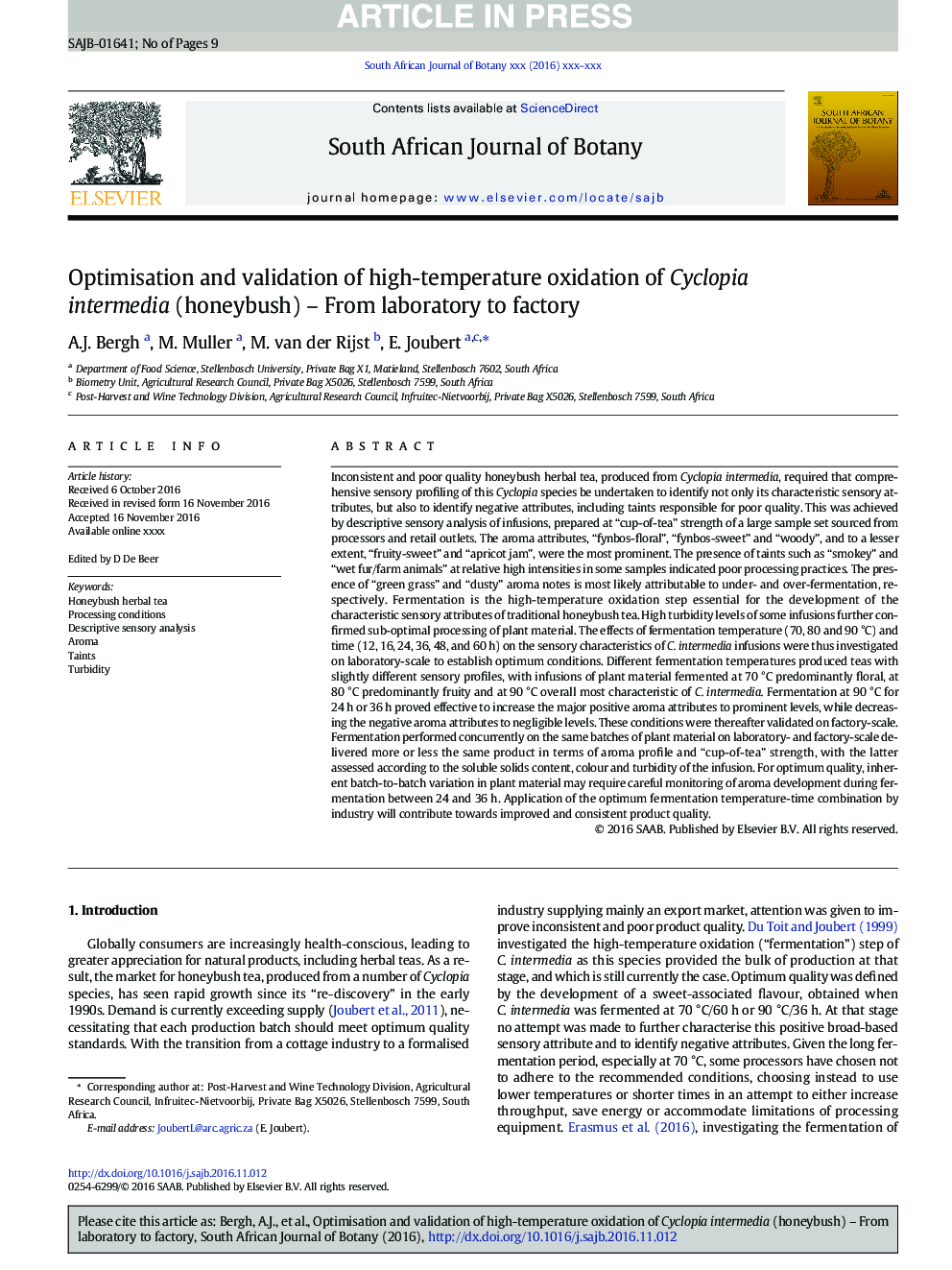| کد مقاله | کد نشریه | سال انتشار | مقاله انگلیسی | نسخه تمام متن |
|---|---|---|---|---|
| 5763009 | 1625148 | 2017 | 9 صفحه PDF | دانلود رایگان |
عنوان انگلیسی مقاله ISI
Optimisation and validation of high-temperature oxidation of Cyclopia intermedia (honeybush) - From laboratory to factory
دانلود مقاله + سفارش ترجمه
دانلود مقاله ISI انگلیسی
رایگان برای ایرانیان
کلمات کلیدی
موضوعات مرتبط
علوم زیستی و بیوفناوری
علوم کشاورزی و بیولوژیک
علوم زراعت و اصلاح نباتات
پیش نمایش صفحه اول مقاله

چکیده انگلیسی
Inconsistent and poor quality honeybush herbal tea, produced from Cyclopia intermedia, required that comprehensive sensory profiling of this Cyclopia species be undertaken to identify not only its characteristic sensory attributes, but also to identify negative attributes, including taints responsible for poor quality. This was achieved by descriptive sensory analysis of infusions, prepared at “cup-of-tea” strength of a large sample set sourced from processors and retail outlets. The aroma attributes, “fynbos-floral”, “fynbos-sweet” and “woody”, and to a lesser extent, “fruity-sweet” and “apricot jam”, were the most prominent. The presence of taints such as “smokey” and “wet fur/farm animals” at relative high intensities in some samples indicated poor processing practices. The presence of “green grass” and “dusty” aroma notes is most likely attributable to under- and over-fermentation, respectively. Fermentation is the high-temperature oxidation step essential for the development of the characteristic sensory attributes of traditional honeybush tea. High turbidity levels of some infusions further confirmed sub-optimal processing of plant material. The effects of fermentation temperature (70, 80 and 90 °C) and time (12, 16, 24, 36, 48, and 60 h) on the sensory characteristics of C. intermedia infusions were thus investigated on laboratory-scale to establish optimum conditions. Different fermentation temperatures produced teas with slightly different sensory profiles, with infusions of plant material fermented at 70 °C predominantly floral, at 80 °C predominantly fruity and at 90 °C overall most characteristic of C. intermedia. Fermentation at 90 °C for 24 h or 36 h proved effective to increase the major positive aroma attributes to prominent levels, while decreasing the negative aroma attributes to negligible levels. These conditions were thereafter validated on factory-scale. Fermentation performed concurrently on the same batches of plant material on laboratory- and factory-scale delivered more or less the same product in terms of aroma profile and “cup-of-tea” strength, with the latter assessed according to the soluble solids content, colour and turbidity of the infusion. For optimum quality, inherent batch-to-batch variation in plant material may require careful monitoring of aroma development during fermentation between 24 and 36 h. Application of the optimum fermentation temperature-time combination by industry will contribute towards improved and consistent product quality.
ناشر
Database: Elsevier - ScienceDirect (ساینس دایرکت)
Journal: South African Journal of Botany - Volume 110, May 2017, Pages 152-160
Journal: South African Journal of Botany - Volume 110, May 2017, Pages 152-160
نویسندگان
A.J. Bergh, M. Muller, M. van der Rijst, E. Joubert,